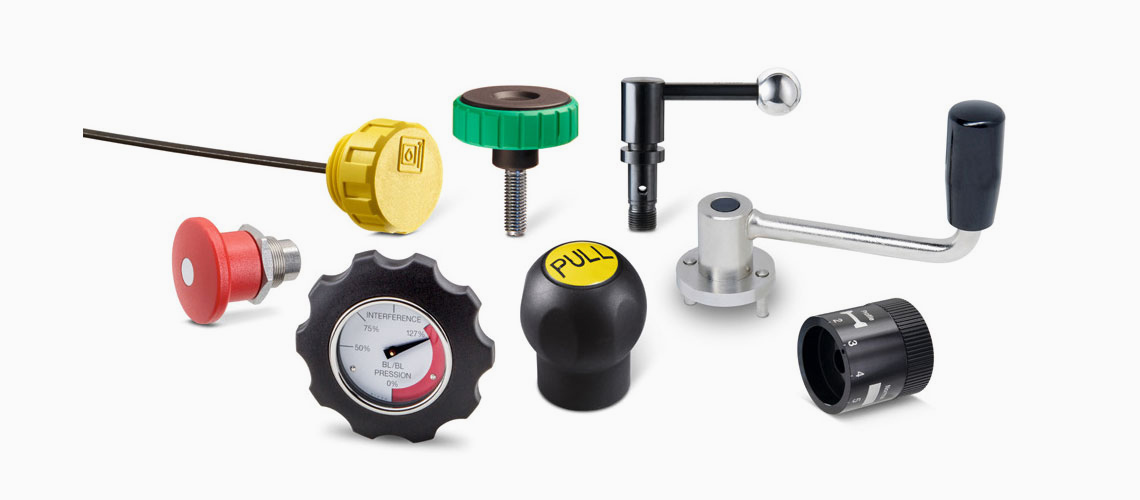Close
Download
Resistance to chemical agents
The table shows the behaviour of ELESA PEB and PES products in the presence of various chemical agents with which they may come into contact in an industrial environment (acids, bases, solvents, lubricants, fuels, aqueous solutions) and provides for three classes of behaviour:
- good resistance = the product functional and aesthetic properties remain unchanged;
- fair resistance = effects on the functional and/or aesthetic properties, depending on the type of product and the working conditions with some limitations of use according to the specific application;
- poor resistance = product susceptible to chemical aggression. Not recommended for use.
| Resistance to chemical agents | |||||
| Material | Effect | Material | Effect | Material | Effect |
| Acetone | ▲ | Paraffin | ▲ | Mineral oil | ● |
| Acetic acid 20% | ❒ | Glue | ● | Oil SAE 70°C | ● |
| Hydrochloric acid 20% | ▲ | Ethylene glycol | ❒ | Carbon monoxide | ● |
| Formic acid | ▲ | Phenol | ▲ | Tetrachloroethylene | ▲ |
| Nitric acid 10% | ▲ | Freon - 11°C | ❒ | Boric acid sol. | ● |
| Oleic acid | ❒ | Freon - 12°C +54°C | ● | Calcium bisulphite sol. | ● |
| Sulfuric acid 50-80% | ▲ | Freon - 22°C | ▲ | Magnesium chloride sol. | ● |
| Tannic acid 10% | ● | Glycerine | ● | Copper chloride sol. | ● |
| Tartaric acid | ● | Sodium hydroxide 46% | ● | Trisodium phosphate sol. | ● |
| Water 50°C | ● | Hydrogen | ● | Ammonium hydroxide sol. | ● |
| Ethyl alcohol | ▲ | Mercury | ● | Calcium hydroxide sol. | ● |
| Methyl alcohol | ▲ | Butanone | ▲ | Soap sol. | ● |
| Carbon dioxide | ● | Naphtha | ❒ | Copper sulphate sol. | ● |
| Petrol | ❒ | Hydraulic oils | ● | Carbon tetrachloride | ▲ |
| Benzene | ▲ | Lubricant oils | ❒ | Toluene | ▲ |
| Butane | ● | Oil ASTM 70°C | ● | Turpentine | ▲ |
● Good resistance; ❒ Moderate resistance; ▲ Poor resistance
-
Generals
-
1. Plastic materials
- 1.1 Mechanical strength
- 1.2 Thermal resistance
- 1.3 Strength and surface hardness
- 1.4 Resistance to chemical agents
- 1.5 Resistance to atmospheric agents and uv rays
- 1.6 Flame resistance
- 1.7 Electrical properties
- 1.8 Surface finish and cleanability
- 1.9 Compliance with international standards
- 1.10 Competence of Elesa+Ganter technical department
- 2. Metal materials
- 3. Other materials
- 4. Machining tolerances
- 5. Fixed handles
- 6. Assembly measures
- 7. Special executions
- 8. Colours
- 9. Test values
-
10. Technical tables
- 10.1 Conversion tables
- 10.2 DIN 79 Square holes and shafts
- 10.3 DIN 6885 Keyways
- 10.4 GN 110 and GN 110.1 Transversal holes
- 10.5 DIN 13 ISO Metric threads
- 10.6 DIN 228 Cylindrical GAS-BSP threads
- 10.7 DIN EN ISO 898-1 | DIN EN 20898-2 Strenght values
- 10.8 DIN ISO 286 ISO-Fundamental tolerances
- 10.9 IP Protection Classification
- 10.10.1 PFB | PRB Thread locking with jamming action Polyamide patch coating/ Polyamide complete coating
- 10.10.2 MVK Thread locking gluing Micro encapsulation precote 80 (red)
- 10.11 Stainless Steel characteristics
- 10.12 Surface treatments
- 10.13 Carbon steel, zinc alloys, aluminium, brass characteristics
- 10.14.1 Duroplast, elastomer, technopolymer and rubber characteristics
- 10.14.2 Duroplast, elastomer, technopolymer and rubber characteristics
- 10.14.3 Duroplast, elastomer, technopolymer and rubber characteristics
- 10.15 Load ratings U-Handles
- 10.16 Load ratings metal hinges
- 10.17 Strength of indexing plungers
- 10.18 Assembly sets GN 965 and GN 968
- 11. Vibration-damping elements
-
1. Plastic materials
- Hygienic design
- Operating Elements
- Clamping knobs
- Control elements
- Rotary controls
- Indexing elements
- Joints
- Transmission elements
- Levelling elements
- Hinges
- Latches
- Toggle, power and hook clamps
- Accessories for hydraulic systems
- Tube clamp connectors
- Castors and wheels
- Magnets
- Conveyor components
- Linear slides
- Vibration mounts
- Vacuum components
- Elastomer springs



